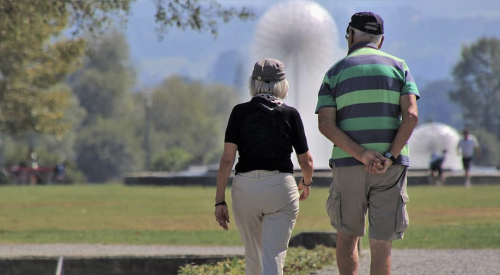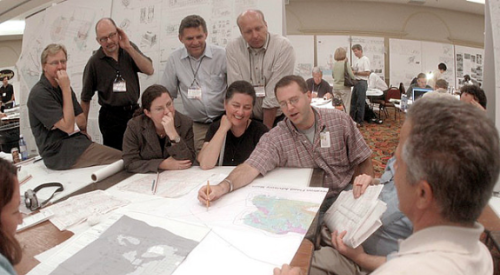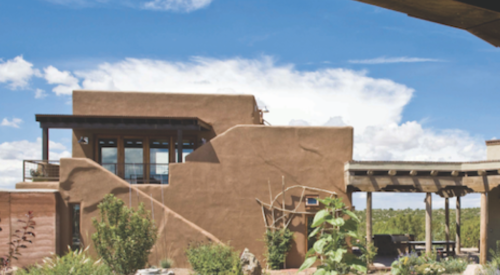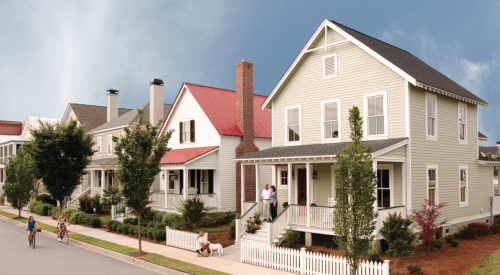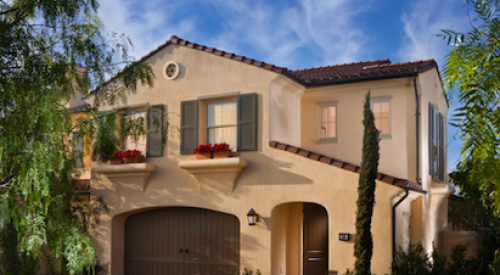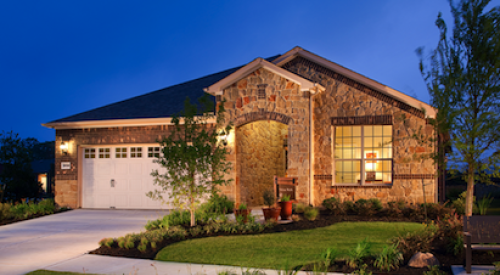|
"Southern Folk" courtyard homes create a nostalgic, pedestrian-friendly street scene. Each has an attached, two-car garage at the rear. Silver Springs Village's land plan (below) turned the 14 acres of larger cottage homes to embrace an access road. Now called Silver Springs Way, the road leads directly into the village green, which is surrounded by 8 acres of office/commercial separating the cottages from the 20 acres of courtyard homes. The Silver Comet Trail borders the community's north edge.
|
|||||||||||||
Number of plans: 12 (7 cottage, 5 courtyard) Square footages: Price range: Buyer profile: Active adults
|
Number of plans: 12 (7 cottage, 5 courtyard) Square footages: Price range: Buyer profile: Active adults
|
Number of plans: 12 (7 cottage, 5 courtyard) Square footages: Price range: Buyer profile: Active adults
|
Number of plans: 12 (7 cottage, 5 courtyard) Square footages: Price range: Buyer profile: Active adults
|
Number of plans: 12 (7 cottage, 5 courtyard) Square footages: Price range: Buyer profile: Active adults
|
Number of plans: 12 (7 cottage, 5 courtyard) Square footages: Price range: Buyer profile: Active adults
|
Number of plans: 12 (7 cottage, 5 courtyard) Square footages: Price range: Buyer profile: Active adults
|
Silver Springs Village, an active-adult project in Atlanta's west suburbs, proves that seniors will flock to a TND community, especially if prices stay under $200,000.
Opportunities
Mark Gibbs, owner of Oakley Development and a partner in Leland Homes & Neighborhoods, both in Marietta, Ga., had coveted this 42-acre site at the western edge of Powder Springs, Ga., long before he acquired it in 2001. In the problems that had doomed two attempts to develop the site, he saw hidden opportunities.
First, an access road to an industrial-looking post office bisects the site. Second, Powder Springs has a history as an entry-level market, and the mayor and city council insisted that this site launch more move-up housing. The resulting conflicts with the landowners landed the parcel in litigation. Thanks to the reputation he had built with the city on a 15-home development earlier in 2001, Gibbs became both sides' choice to come up with a compromise.
The site is adjacent to the Silver Comet Trail, a hiking and biking trail that eventually will stretch from Atlanta to the Alabama border thanks to federal, state and county funding. "I've always tried to anticipate market movement," Gibbs says. "That trail is a great recreational amenity for active adults. We saw that this site had great potential to target seniors, which is our specialty."
Obstacles
This project, however, was bigger than any Gibbs had done, so he brought in another local company, McKenzie-Perry Homes, as a 50-50 builder partner. (Owner Tony Perry also has a 7.5% equity stake in the project.)
To find a product that would sell fast and still meet the city's objectives, Gibbs assembled an all-female design team: market researcher Cecilia Davidson-Farkas of Marketing Synergy, marketer Vicky Babcock of Babcock & Associates, interior merchandiser Donna Mathis of DMD Design Group and local residential designer Debbie Hartman. "Builders often make a mistake by excluding women from the design process," says Gibbs, who believes that women wield more home buying influence than men.
Gibbs and Perry allowed the team to painstakingly research the site, the housing market in a 10-mile radius and, finally, the psychographics of active adults in the draw area.
All of that led to this conclusion: a traditional, mostly rear-loaded neighborhood of two product types - larger cottages for move-down, active-adult couples and smaller, higher-density, zero-lot-line courtyard homes targeted to single-again females older than 50. "The city wasn't thrilled that we wanted to increase the density and price the homes under $200,000," Gibbs recalls. "But we showed them that the active adults we wanted to target would not burden city resources. They wouldn't put kids in the schools and wouldn't use the roads at rush hour. Moreover, they wouldn't add to crime-prevention or crime costs. Instead, they would spend much more than they cost."
Gibbs spent nearly a year working on the "Southern Folk" design of the innovative, five-per-acre courtyard homes. Fortunately, McKenzie-Perry already was building small courtyard homes that the design group recognized as a perfect starting point. "We'd built that type of home to densities as high as seven units to the acre," Perry says. "What we had to do here was increase the size of the homes to get the right features to meet the active-adult market and give the city what it wanted."
The cottage homes, built three to an acre, faced inward in the original plan, but the partners turned them to face the street, using it as a link to the village green, the courtyard homes and all of Powder Springs. "The city loves it, and so do our buyers," Gibbs says.
Outcome
Heading into this spring selling season, the builders had sold 30 of the 41 cottages and 92 of the 100 courtyard homes since sales opened in September 2002.
"If you go to housing seminars, you may hear that seniors don't like TNDs," Davidson-Farkas says. "Nothing could be further from the truth. That market is full of single-again women, divorced or widowed. They want to connect with neighbors. A TND does that. And the courtyard home is perfect for them. It's secure, and the side courtyard is the kind of small, private outdoor space they want."
Gibbs says other aspects of the courtyard design also appeal to single women. "We knew we had to keep garages attached. That's a major security issue. We had to take lawn maintenance out of the equation. The pedestrian-friendly, connected streets were gravy."
While the cottages occupy 50- and 60-foot lots 110 feet deep, courtyard homes are on lots only 35 feet wide but 130 feet deep. Only 7 feet on each side separate them. Rear alleys are 12 feet wide when one-way and 18 feet when two-way.
All of the homes feature reduced-maintenance exterior materials, including fiber-cement siding, and homeowners association dues cover landscape maintenance for the courtyard homes, even though homes are sold fee-simple.
Fifty-two of the 92 courtyard buyers are single women, while only three of 30 in the cottages fit that profile (73% are couples). For the full project, 81% of buyers are active adults age 50 to 70, even though the project was age-targeted, not age-restricted.
